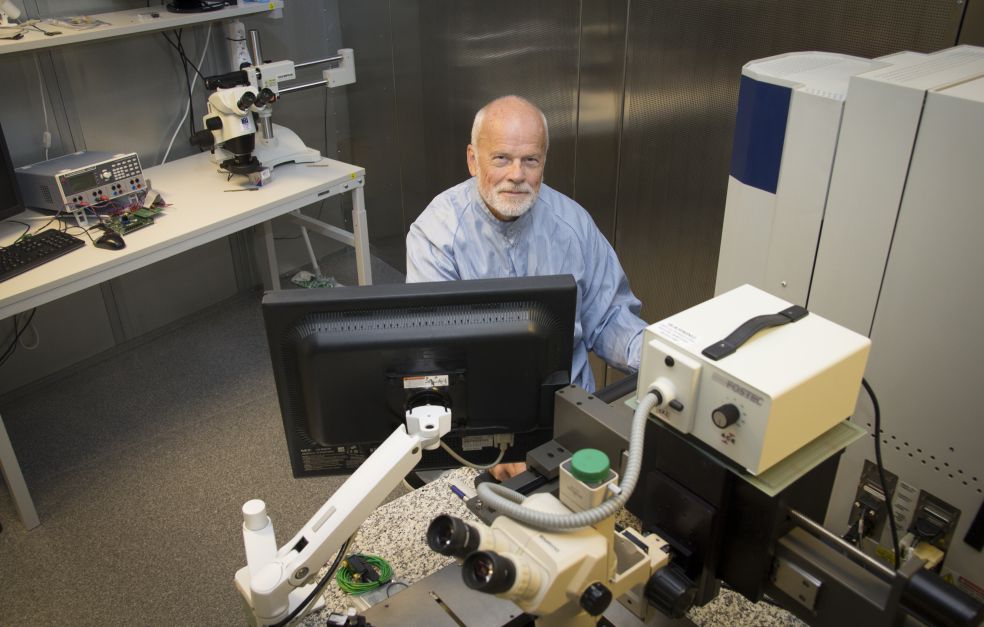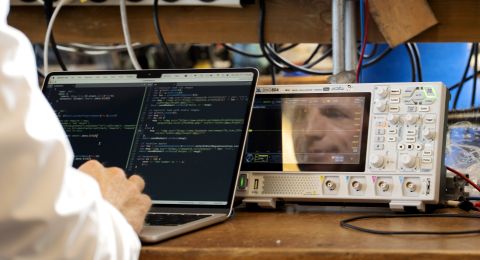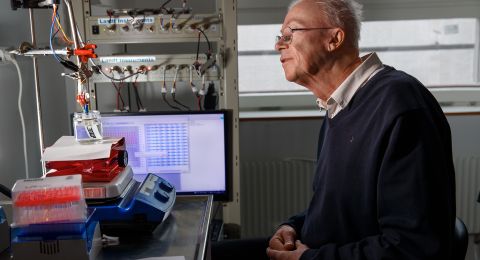
Project Grant 2019
Light dark matter
Principal investigator:
Torsten Åkesson, Professor of Particle Physics
Co-investigators:
Lund University
Caterina Doglioni
Ruth Pöttgen
Chalmers University of Technology
Riccardo Catena
Stockholm University
Jan Conrad
Institution:
Lund University
Grant in SEK:
SEK 26 million over five years
The matter we see around us – making up the chair you are sitting on, flowers and stars – actually represents only a small proportion of all matter in the universe. The rest is something else – something we call dark matter.
“Eighty-five percent of all matter is dark matter – and we don’t know what it is. Attempting to find out goes to the very heart of our understanding of the world,” says Torsten Åkesson, a professor of particle physics at Lund University.
He is leading a project that brings together researchers at Lund University, Chalmers University of Technology and Stockholm University in a new approach to the mystery of dark matter. The project is being funded by a grant from Knut and Alice Wallenberg Foundation.
The hunt for dark matter
Dark matter is called “dark” because it neither emits nor absorbs light. But although it is invisible to us, we know it exists. For instance, stars and galaxies would not move as they do if they were not influenced by the gravity exerted by dark matter.
The phenomenon of dark matter was discovered as long ago as the 1930s. But its composition remains unknown, and the hunt is on to identify its constituents.
One approach is to try to detect dark matter particles as they flow through the Earth. Most of them pass by entirely unaffected, but a few could collide with nuclei of atoms. Experiments are in progress to try to detect such collisions using large underground detectors.
Another line of inquiry is based on producing dark matter in laboratories. The ATLAS experiment at the CERN laboratory in Switzerland and France is one example. There, protons traveling in beams at close to the speed of light are made to collide with each other, in the hope that the energy this generates will create particles of dark matter.
To date these experiments have not observed such reactions.
Lighter particles
By assuming that dark matter was the result of an equilibrium between ordinary matter and dark matter in the early universe, the researchers have a framework placing constraints on the possible mass of the constituents of dark matter. They must then have a mass of more than an electron but less than tens of times the mass of a lead atom.
Åkesson points out that the heavier end of the scale is being quite thoroughly explored, but so far without scientists finding what they were looking for. For this reason, he and his colleagues want to examine the possibility that dark matter consists of lighter particles – roughly between the weight of an electron mass and that of a proton mass.
“As we gather all knowledge about what dark matter should be, it’s reasonable to look in this range of masses, which we call ‘light dark matter’.”
Demanding experiments
To create and detect light dark matter, Åkesson and his fellow researchers have designed an experiment that will be performed using the LCLS-II particle accelerator at SLAC National Accelerator Laboratory at Stanford in the US. A beam of electrons will be aimed at a thin foil made of tungsten. When the electrons collide with atomic nuclei in the metal, reactions creating dark matter may occur.
But this is expected to occur only very, very occasionally. The researchers expect they will need to study roughly 1014 – i.e. ten followed by 14 zeros – collisions to have a chance of finding the reactions they are looking for. And the electrons cannot all be fired off at once.
“We need to have a beam in which the electrons are separated from each other, arriving at intervals of 20 nanoseconds, so we can see what happens in each reaction. This will require a steady beam operating for approximately eight to nine months.”
The results of the collision are recorded by detectors of various kinds. In particular, the researchers will be measuring the momentum of the electrons as they enter the foil, compared with their momentum as they leave it. If there is a difference, and no other known particles have been detected, a reaction may have occurred giving rise to particles of dark matter.
A crucial factor is the ability to disregard reactions in which dark matter is not produced. Most are easy to predict, but since the researchers are studying so many reactions, unusual events may also occur. Åkesson explains:
“It’s important not to mistake a highly unusual, but known, physical reaction for one in which dark matter is produced. This is one of the major challenges posed by the experiment.”
The researchers are using machine learning to teach computers to recognize the signatures of various reactions. They are developing models of the physics describing dark matter, and data simulations of the reactions envisioned in the experiment. They are also producing statistical tools so they can interpret their experimental results.
It is hoped that knowledge gained from the experiment can also be used to ascertain which materials are optimal for use in future underground detectors focusing on light dark matter.
New view of the world
If the researchers can show that the dark matter is actually light, this would be proof of hidden physics – with little contact with the known forces of physics – governing how dark matter is affected.
“That would give us a new broader way of looking at the world,” Åkesson concludes.
Text Sara Nilsson
Translation Maxwell Arding
Photo Johan Joelsson and Cern
A Swede among the pioneers
The term “dark matter” was used as long ago as 1930 in an article written by an astronomer called Knut Lundmark at Lund University. He demonstrated that “dunkle Materie” (dark matter) was needed to understand how galaxies remain intact. His contribution was forgotten, however, and until just a few years ago the Swiss astronomer Fritz Zwicky was usually credited with being the first to describe dark matter, in an article published in 1933.
But these early papers were not widely read, and it was a surprise to most people when the American astronomer Vera Rubin reported observations in the 1970s that systematically showed there to be an unknown, invisible kind of matter in galaxies, and that it is present in much larger quantities than the ordinary matter we know about.
Sources: Torsten Åkesson and Fysikaktuellt no. 2, 2018





